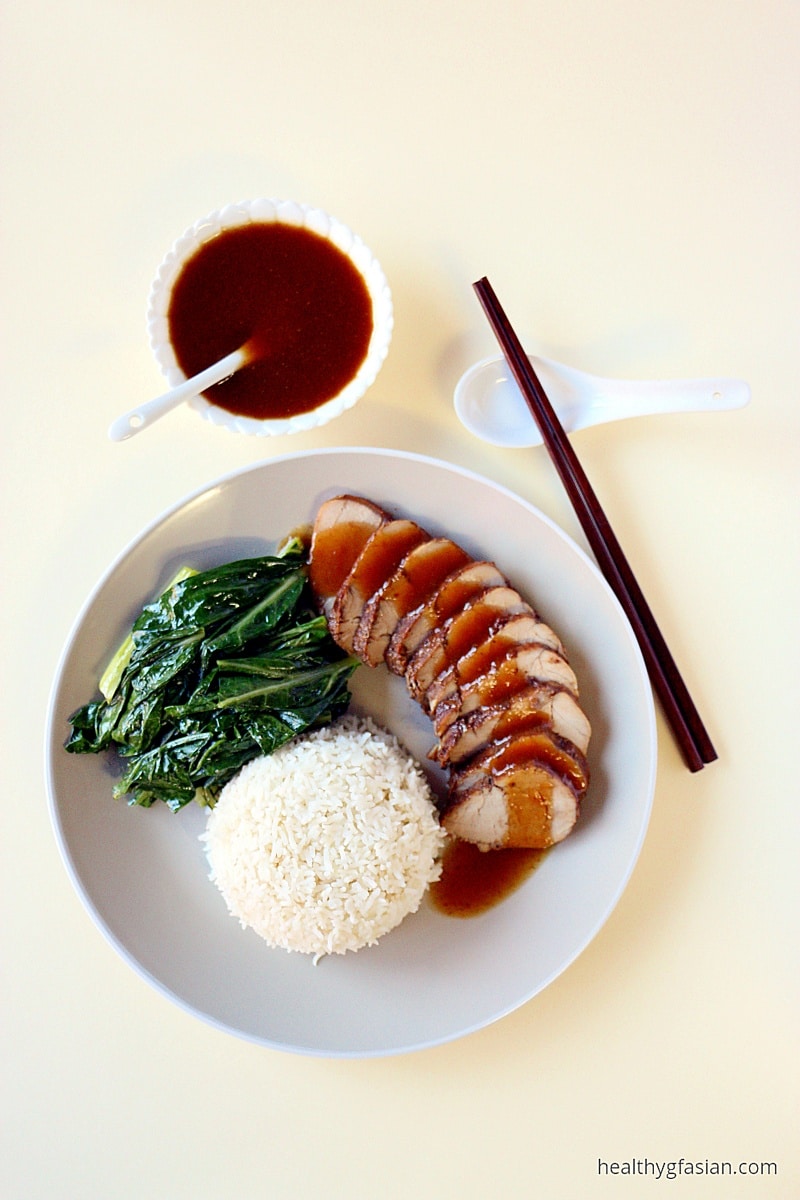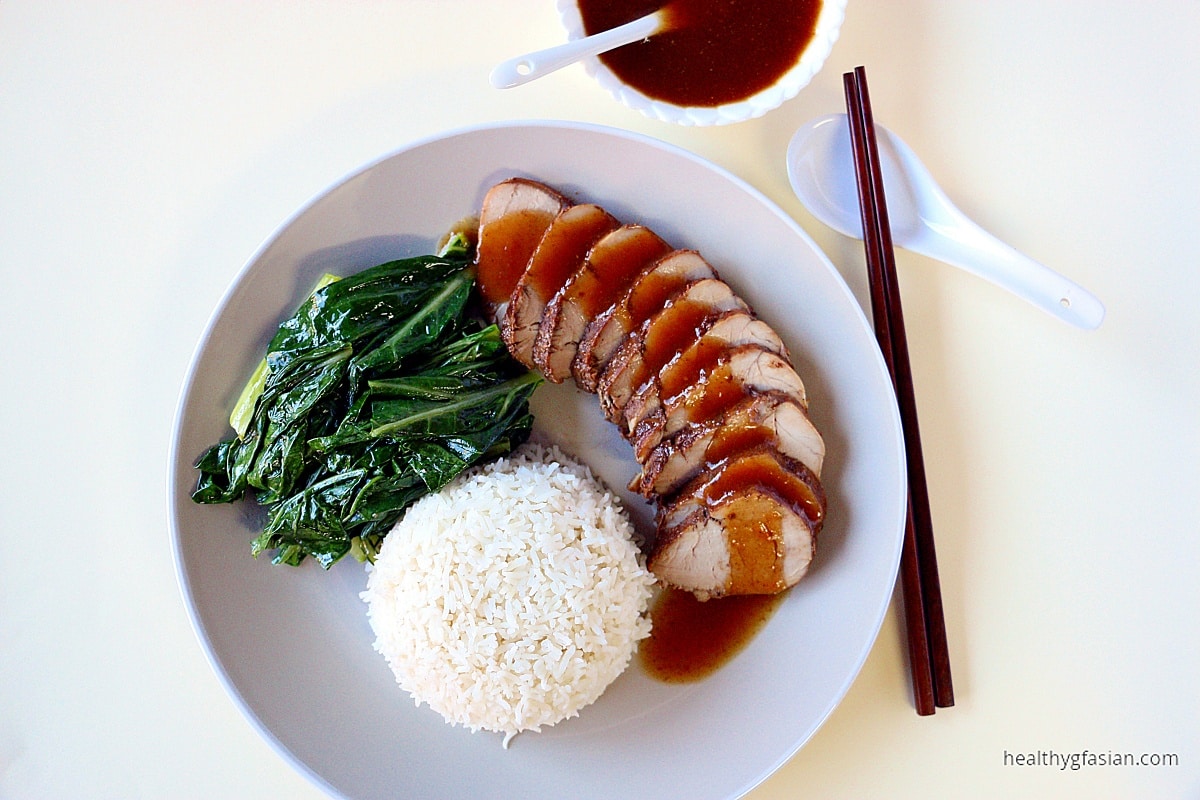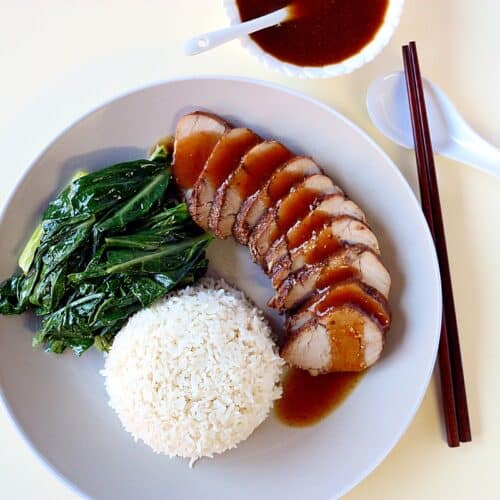Chinese Barbecue Pork Rice or (Char Siu Fan) is a popular way of serving Cantonese seasoned spiced up barbecued pork. Besides, char siu exactly means “fork roast” in Cantonese. Likewise, they named char siu after the old–fashioned technique used for cooking this dish. Whereby they skewer long pieces of flavoured boneless pork with long forks. Then roasted in an enclosed oven or above a wood or charcoal fire. Moreover, Cantonese roasted meat or siu mei include char siu, roasted pork belly or roasted pork and roasted duck.

Methods of making Chinese Barbecue Pork (Char Siu)
Today, barbeque pork or char siu is usually a cut of pork shoulder. But many people also commonly use pork butt, pork neck and pork belly. Although, another popular cut used is pork fillet. Besides, they marinate these cuts with a sauce mixture. Made up of light soy sauce, dark soy sauce, honey, fermented red bean sauce and hoisin sauce. Plus Chinese five spice powder, rice wine and red food colouring added to make the barbecue pork red in colour. They also apply maltose to give barbecue pork its typical glossy glaze.
For my gluten free Chinese Barbecue Pork Rice (Char Siu Fan) recipe, I am using pork fillets. I marinated the pork fillets in a gluten free sauce mixture. Including gluten free light soy sauce, gluten free dark soy sauce, gluten free oyster sauce, and gluten free hoisin sauce. As well as Chinese five spice powder, honey, pale or medium dry sherry and a hint of ground paprika. In addition, I used honey and dark brown sugar for my shiny glaze for the barbeque pork. This gluten free Chinese Barbecue Pork Rice is also low carb, dairy free, egg free and nut free.

Ways of Serving Chinese Barbecue Pork (Char Siu)
In general, they eat Chinese Barbecue Pork (char siu) together with some carbohydrates. Specifically, rice called “cha siu fan”, and with wonton dumplings noodles called “cha siu wonton mein”. Alternatively, with just barbecue pork and noodles called “cha siu mein”). Moreover, they use barbecue pork as fillings within a bun called “cha siu bao”. Chinese Barbecue Pork Rice char siu fan, cha siu wonton mein and char siu mein are typical street/hawker foods. They also serve them at many Asian chain restaurants. Mainly in Malaysia, Singapore and Indonesia. Moreover, they serve Chinese Barbecue Pork Rice with cucumber or blanched choy sum. Plus barbecue pork sauce on top of the steamed rice.
While they normally eat Chinese Steamed Barbecue Pork Buns (Char Siu Bao) as part of dim sum during yum cha. Likewise, they serve barbeque pork mostly by itself as a main dish. Besides, they serve barbecue pork together with roasted pork and roasted duck in Chinese family restaurants in Asia and worldwide. When they purchase barbecue pork as a take away from Chinese specialty restaurants selling siu mei or Cantonese roasted meat. Moreover, they use barbecue pork for home dishes like yong chow fried rice. Or included as an ingredient in many vegetable or meat dishes that utilises barbecue pork.


Chinese Barbecue Pork Rice (Char Siu Fan)
Ingredients
- 1.5 kg pork fillets trimmed
- 2 bunches choy sum washed and cut into 8cm in length
- 2 tablespoons extra virgin olive oil
- Steamed rice to serve
For the Marinade:
- ⅓ cup rice bran oil
- 50 ml water
- 2 tablespoons gluten free light soy sauce
- 2 tablespoons gluten free kecap manis
- 2 tablespoons gluten free oyster sauce
- 2 tablespoons gluten free hoisin sauce
- 4 tablespoons medium dry sherry
- 2 teaspoons Chinese five spice powder
- 1 teaspoon ground paprika
- 1 tablespoon honey
- ½ teaspoon salt
- 1 teaspoon ground white pepper
For the Glaze:
- 5 tablespoons honey
- 1 tablespoon dark brown sugar
- 50 ml water
For the Sauce (400ml):
- reserve sauce in baking tray after cooking the barbecue pork
- 2 tablespoons corn starch mix with 2 tablespoons (30ml) water
- 75 ml water or more if required
Instructions
For marinating:
- Combine and mix all the marinade in a large bowl and marinade the pork fillets. Place the marinaded pork in an airtight container or place and seal in a ziplock bag. Leave in the refrigerator overnight or for at least 4 hours.
For roasting:
- Preheat fan forced oven to 170C or 340F. Line a deep baking tray with 2 layers of baking or parchment paper.
- Add the pork fillets onto the non-stick large baking pan. Brush some of the marinade onto the top side of the pork and reserve the rest of the marinade for basting during roasting.
- Roast the pork fillets in the oven for 25 minutes on each side, brush the reserved marinade half way through roasting each side of the pork fillets.
For the glazing:
- Prepare and mix the glazing sauce ingredients in a small bowl.
- At the end of roasting each side, brush the honey glaze generously. Then roast at 160C or 320F for 3 to 5 minutes on each side.
- Remove the pork fillets from the baking tray and place on a large plate to rest.
For the sauce:
- Carefully pour all the sauce in the baking tray through a fine sieve into a measuring cup.
- Add the corn starch mixture and 75ml water for the sauce into the measuring cup, you need total of 400ml sauce mixture. Add more water if required.
- Pour the 400ml sauce mixture into a small pot, mix well and bring to a boil. Turn off the heat once boiled. This is the serving sauce for the barbecue pork.
For cooking the choy sum:
- Heat up a medium pot half filled with water and bring to a boil. Turn the heat to low and briefly blanch the choy sum together with the extra virgin olive oil for 2 minutes or until the choy sum turns bright green in colour.
For serving:
- Thinly slice the barbecue pork.
- Serve the barbecue pork together with the sauce, some blanched choy sum and steamed rice.










Thank you for this! I love the background that accompanies the dish.
Do you know what the sauce is that’s usually poured over the rice when served with the pork? It’s different than char siu and seems to be soy based.
The sauce for serving with the rice and char siu is normally made with soy sauce, hoisin sauce, honey, Chinese cooking wine like Shaoxing wine or dry sherry and Chinese 5 spice powder. 🙂
I’m sending this straight over to my husband – he loves barbecued pork!
Bon appétit to your husband. 🙂
That’s a very beautifully laid out plate of food Daphne. I don’t think I’ve ever managed to get my rice to look so appealing.
Thanks for your nice comment Choclette! 🙂